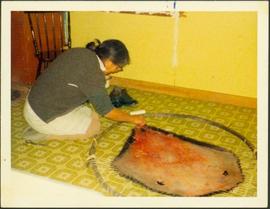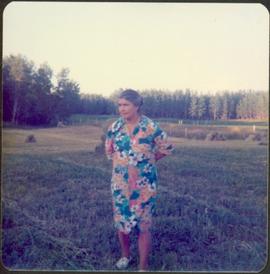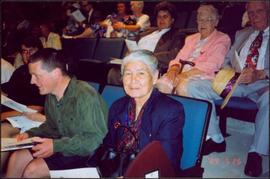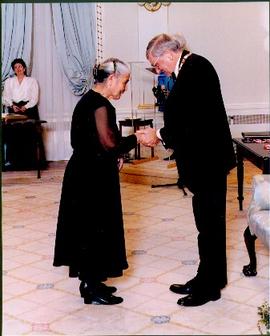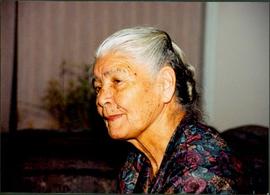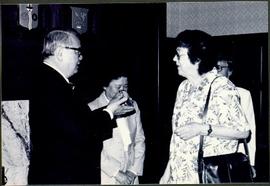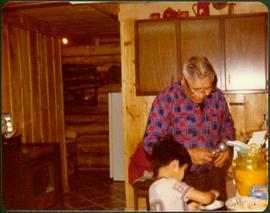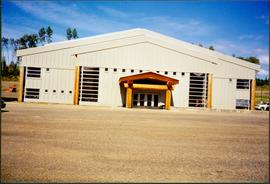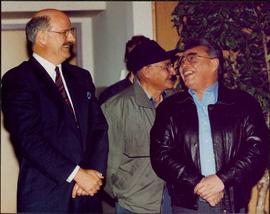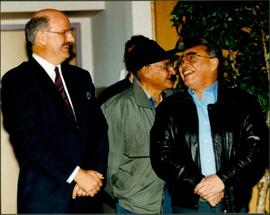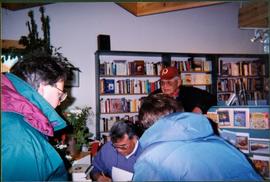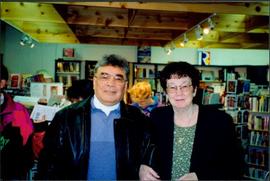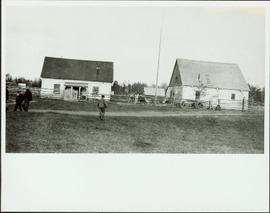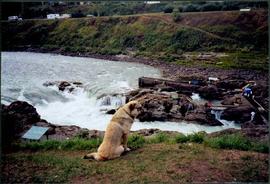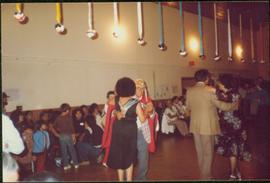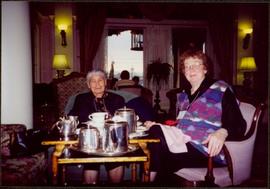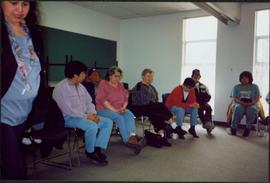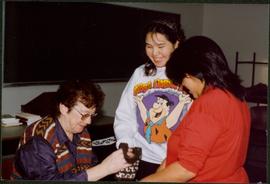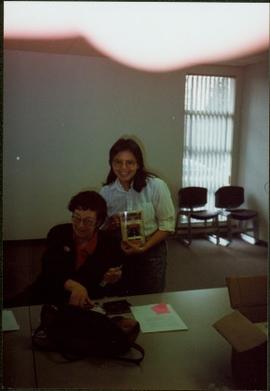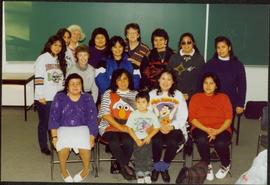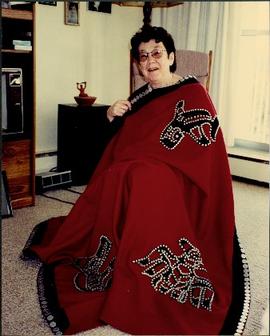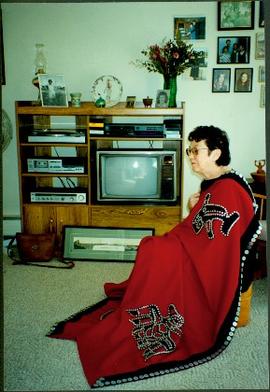Photograph depicts Mary John kneeling on floor while stretching hide. Chair and shoes in background.
Photograph depicts Mary John wearing flower print dress in cut field. Hay bales, trees, and fence in background.
Photograph depicts Mary John sitting next to aisle in Canfor Theatre at the University of Northern British Columbia in Prince George, B.C. Unidentified individuals seated in foreground and background. Accompanying note from Maureen Faulkner: "Mary John takes my seat." Photo taken on the day Bridget received an Honourary Law Degree, before ceremony began.
Photograph depicts Mary John shaking hands with unidentified man at official ceremony where she was awarded the Order of Canada for outstanding service to her community. Two unidentified woman stand in background in large ornately furnished room.
Audio recording consists of an interview conducted by Bridget Moran with Mary John.
Audiocassette Summary
00’05” Bridget is interviewing Mary John who discusses a potlatch held at Stoney Creek that Bridget attended. Bridget asks about the talking stick and she asks Mary John to explain its significance. Mary explains there had been a naming ceremony about a year ago and that a woman named Maisie had changed clans from her mother to her father’s clan. Mary notes while this is unusual, her father’s only son had died and therefore requested that the daughter changed clans. At this ‘September potlatch’ therefore this woman had to change tables at the potlatch.
04’00” Mary explains the context of the September Potlatch. She notes that Maisie had hosted this potlatch to pay back for the gifts that had been provided for her from a year ago when she received a new name. They then discuss the amount of money that the host gave to the guests and the amount of money that is normally provided – there is no particular amount ‘whatever you wish’ Mary notes she had provided Maisie with a gift last year of $100 but that Maisie gave her back $200 – that is not required – there is no required amount
07’30” Mary explains that at a potlatch you are expected to bring a case or few bags of food
08’00” Mary discusses the type of food provided at a potlatch; it is traditional food not western food; Bridget notes there was caribou provided there. Mary explains that the host of a potlatch asks people to hunt for moose and deer meat in order to prepare for the food to be served. Bridget then talks about the food that was served and Mary notes it included also fish and beaver.
11’00” Bridget asks Mary to talk about the gifts given to her daughter Flo at the potlatch in exchange for a loan she provided to another woman whose husband had died a year before. Bridget notes it was a ‘touching’ moment.
12’00” Mary talks about the Priest ‘Father Brian’ who was at the potlatch. Four clans collected money and gave it to the priest for his work [missionary work?]
15’07” Mary explains the situation of Geraldine Thomas –that at the potlatch she was not seated before; that is she was not initiated before and so she was seated at the potlatch
15’57” Tape stops momentarily
16’09” Mary continues to talk about Geraldine and the potlatch events; the significance of the tapping of the talking stick; then she was seated and guests give her gifts. Then Mary talks about Ernie and her late daughter Helen who also wanted to cross their clan but that Mary ‘did not let her go’
20’00” Mary talks about the feelings of a child who gives up their clan and that it is like ‘giving up one of your children’ as Celina noted to Bridget at the event.
21’00” Mary talks about her son Ernie who crossed over to his father’s clan and that he was gifted at the potlatch
22’00” Bridget then notes that at this potlatch that the Frog Clan became host of the Grouse clan at this potlatch. Mary explains that the clan then had debts to pay at this potlatch.
26’00” Mary talks about the death of Stoney Creek members; she is unsure when there will be another potlatch in Stoney Creek.
28’00” Bridget notes that she did not understand the ceremony as it was in Carrier language; however Bridget notes it is a pity the white world doesn’t see potlatches as they are ‘so touching’
31’00” Mary explains that each clan takes care of the deceased family members and takes care of putting up the headstone
32’00” Tape ends abruptly
Close view of Mary John. Plant, couch, and window in background.
Audio recording consists of an interview conducted by Bridget Moran with Mary John.
Audiocassette Summary
Scope and Content: Tape consists of a recording of Bridget interviewing Mary John primarily about her visit to the former native village site of Cheslatta
Side 1
Interview in process
00’05” Bridget interviews Mary John, Mary is referring to Madeline her niece.
1’00” Bridget asks Mary what made her decide to go to Cheslatta – to see the site where she had lived. Bridget asks if it was a ‘rediscovery’ trip. Bridget asks if this is where the village was burned out and flooded out [by Kemano development] Mary talks about her son Ernie wanting to go there and create a territorial hunting ground. She talks about going there with her niece Madeline and Alex
8’40” Mary explains how they got to Cheslatta; the travel there was by van through Francois Lake and via logging roads; it took about hour and half drive
11’00” Mary explains it was not the village that had been flooded that they went to; not the original village; she notes there was a campsite set up for them but it was cold at night. There were people there from Stellaco, about 75 total. She describes making bannock on a stick over the fire ‘the real bannock’ for the youth – like an “Indian pizza” (she laughs)
16’00” Mary continues to talk about the activities that she did at Cheslatta; show the youth how to fish, spear fish, clean fish, cut in strips and smoke the fish. There was no smokehouse but they created a lean- to and smoked the fish. Mary also notes another day Mary and Madeline took the youth to the bush and talked to them about uses of trees –
22’00”-20’25” Mary describes the steps involved with showing the youth at the Cheslatta camp how to collect spruce in order to build a smoke house for smoking the fish
29’30” Mary discusses food that she prepared for the gathering for the people
31’00” Mary talks about the group visiting the old village Cheslatta after the gathering
Mary then leaves to attend to a crying baby [a great-grand-child?]; they greet the mother
33’00” Bridget refers to a group of kids she talked to at Kamloops about their book Stoney Creek Woman. Bridget tells Mary she has letters written to Mary John by several students who had read Bridget’s book that she wants to show her
36’00” They continue to talk about the former Cheslatta village and what the former village residents want to do about the village; Mary notes there are archaeologists working there. Mary states the people have not yet received compensation for being taken off their land. Bridget notes those people loss their sense of community
38’31” Mary remarks the people at Cheslatta “have a good chief” “very humble person”
39’40” Bridget asks Mary about the Lejac pilgrimage. Mary then talks about the pilgrimage that is held at Lejac and that she had just been there ‘on Sunday night’; she notes it is arranged by Celina; she notes there were Tache people there. Bridget asks if there are children buried at Lejac and Mary notes there are children and students buried there – about 15 to 20 buried there.
43’00” They briefly discuss if this was a rediscovery for the Cheslatta people at the event. Mary agrees; she notes she stayed there for 10 days; Bridget remarks it was similar to Mary’s former camp of what she had experienced at Wedgewood. They talk about Mary’s son Ernie and that he has in Bridget’s view ‘leadership qualities”
45’30” Bridget asks about getting a bannock recipe for a Senior’s cookbook. Mary begins to tell the recipe
Side 2
47’40” Mary continues to show Bridget how to make bannock
50’00” Mary briefly refers to the event at Cheslatta again
End of tape
Audio recording consists of an interview conducted by Bridget Moran with Mary John.
Audiocassette Summary
Context: Tape recording is an interview between Bridget and Mary John in which Bridget initially asks Mary John about events after the inquest into Coreen Thomas’s death. Bridget notes also that she wants to provide an update on Mary John’s life 10 years after the inquest.
Side 1
00’05” Bridget asks Mary John about her role in the Coreen Thomas inquest. Mary thinks that she discovered Coreen’s death due to the ringing of the church bells [to announce a death]. She tries to recall the series of events leading up to her time being involved in getting an inquest. Recalls Sophie Thomas’ desire to have an inquest into her death
6’00” -10’00” She recalls that the [Indian] Homemakers Association became involved in attempting to get an inquest. She says ‘she was just tagging along with it …I was not a fighter” Bridget notes that Harry Rankin stayed at Helen’s house when he represented the Homemakers Association at the inquest. Bridget recalls the ‘marvellous’ dinner that was put on for them at the time of the inquest by Mary John and Helen. Mary John notes it was at the invitation of the Homemakers Association for the group to come to her house.
10’:00”-14’00” Bridget and Mary talk about follow-up to the inquest and Coreen’s family.
14’50”- 25’00” Mary talks about her involvement as well as others in the creation of the Elders Society after the death of Mary’s son due to drowning in 1978. The Society had workshops in an effort to revive their culture with the hope of having the younger generations take pride in their culture. One of the activities was the building of the Potlatch House in 1980 where they did traditional activities including tanning of hides.Talks about acquiring the land to build the potlatch house and having the Chief take care of getting the land from BCR; the Society cleared the land twice over to set up the house. Mary explains that the Society acquired funding of $93,000.00 from ARDA [?] to clear the land from the logs and build the house.
26’00”-30’00” Mary talks about a new project that the Society has to build 10 rental tourist cabins as a business for the youth to operate. Bridget suggests it could be similar to that at K’san. Mary also explains that there is a cook-house at the Potlatch House as well and that it has been used for community events, weddings, dinners, organizational events also.
Tape stops momentarily and starts again
30’05”- 36’00” Mary talks about the drowning of her son and finding of his body in 1978 as well as other tragedies that happened in the community which led to the creation of the Elders Society to assist the youth
36’30” -39’30” Mary talks about the joys of finally having her own house and the building of the house
39’32” -42’40” Mary talks about the organizations that she is involved in now. She talks about a film made in the community about social workers coming in the community to work with Elders to care for issues related to youth. She notes that ‘that’s when the ice broke’ and it made a difference.
43’00” She talks about a dinner that she holds every year for the police officers to thank them for the service they do for society
43’30” Talks about fishing at Fraser Lake
44’00” -46’00” Mary talks about her work now at her house to teach the youth about their culture: making of baskets, moccasins, tanning of hides
End of side 1
Side 2
46’30”-48’00” Mary continues to talk about the activities that she does with native youth to educate them about their culture
48’50” Bridget asks about whether the youth are involved in tree-planting and asks another woman in the room (Bernice?)
50’00” – 56’00” Bridget asks what her three wishes are for her people: better lives; more education for the young people to have better jobs; they need to get out to the white world and not be so isolated; she refers to when she worked in ‘the white world’ She talks about the isolation of the reserve and yet the protection that it offers to the people as well. Bridget and Mary talk about the reserve offering a way to protect the native culture. Bridget asks why it is important to protect their culture. Mary notes their culture is so important; she notes that other cultures like Japan and China haven’t lost their culture so why should the natives.
56’05” Mary notes that none of the grandchildren speak Carrier and the need to protect their culture and language when being surrounded by a white community. Refers to her grandson Fabian who is in the room
57’00” Bridget recalls a Fort St. James woman who tried to keep native kids out of white schools. She wanted them to be kept on the reserve so that they didn’t lose their culture. She talks about the fight by many to get their native status back – those whose one parent is not native
58’00” Mary talks about her worries for the young native people in the community who fear they have no future and who have no employment or education.
End of tape
Handwritten annotation on recto: "His Honour David C. Lam congratulates Bridge Moran of Prince George for her award winning book - Stoney Creek Woman." Lieutenant Governor Lam stands in formal attire on left, presenting medal to Moran. Two woman stand in background.
Photograph depicts Lazare John (husband of Mary John) dishing ice cream onto plate of pie. Young boy in foreground, kitchen and hallway in background.
Photograph depicts unidentified building with large wood beams in entryway.
File consists of newspaper clippings:
- "Surrender" (The Georgia Straight, July 19-26)
- "The Kemano deal: scientists, salmon sacrificed" (The Watershed, Nov. 1993)
- "Carrier-Sekani people speak for the fish" (The Watershed, Nov. 1993)
- "Alcan bid rejected by Court"(Canadian Press, Sept. 26, 1994)
- "Kemano hearings concluded" (The Democrat, Autumn, 1994)
- "What's up with Kemano II" (The Democrat, Spring, 1994)
- "How Kemano deal came to happen" (The Prince George Citizen, Aug. 13, 1994)
- "Memos reveal Kemano project conflicts ; editorial comments" (The Prince George Citizen, Oct. 14, 1994)
- "Kemano battle shifts to Ottawa" (The Prince George Citizen, Dec. 9, 1992)
- "Scientists condemn Kemano deal" (The Prince George Citizen, May 27, 1994)
- "North must stick together to protect river" (The Prince George Citizen, Feb. 6, 1993)
- "Controversy clouds start of hearings" (The Prince George Citizen, Nove. 9, 1993)
- "Alcan explains contract" (The Prince George Citizen, July 15, 1994)
- "Fisheries chief stays out of Kemano controversy" (The Prince George Citizen, April 7, 1994)
- "Kemano hearings reconvene in city" (The Prince George Citizen, July 19, 1994)
- "Exemption on Kemano ruled illegal" (The Vancouver Sun, May 25, 1993)
- "Kemano opponents get federal cash" ((The Prince George Citizen, March 31, 1994)
- "Ottawa joins Kemano project inquiry" ((The Prince George Citizen)
- "Your Opinion" ((The Prince George Citizen, Oct. 28, 1993)
- "Kemano hearings almost at an end" (The Prince George Citizen, July 23, 1994)
- "Siddon proud of Kemano deal" (The Prince George Citizen, July 22, 1994)
- "Former fisheries minister testifies" (The Prince George Citizen, July 21, 1994)
- "Social, economic costs of Kemano described here" (The Prince George Citizen, July 20, 1994)
- "Siddon anticipated" (The Prince George Citizen, July 16, 1994)
- Editorial comment on the Kemano project by Carolyn Linden (The Prince George Citizen, July 16, 1994)
- "Pulp mill's effects debated" (The Prince George Citizen, July 13, 1994)
- "Farming issues raised at Kemano hearing" and "Float plane operators worried about project" (The Prince George Citizen, July 12, 1994)
- "Vanderhoof wary about Alcan plan" (The Prince George Citizen, July 11, 1994)
- "Natives seek..." (The Prince George Citizen, June 4, 1994)
- "Where will the power from Kemano..." (The Prince George Citizen, June 11, 1994)
- "Scientists testify at inquiry" (The Prince George Citizen)
- "Threat to Tweedsmuir Park predicted"
- "Protesters disrupt inquiry" (The Prince George Citizen, June 24, 1994)
- "Power struggle" (The Weekend Sun, April 23, 1994)
- "Council rates Nechako 'most endangered river'" and "Alcan finds no evidence of PCB contamination" (Lakes District News, May 18, 1994)
- "Siddon wanted at hearings" (The Prince George Citizen, May 20, 1994)
- "Weed growth fears expressed" (The Prince George Citizen, July 8, 1994)
- "Chemical threat to river feared" (The Prince George Citizen, April 14, 1994)
- Newspaper advertisement: "Five things you should know about Kemano Completion" (The Weekend Sun, April 23, 1994)
- "Retired scientist says he was told to support gov't" (The Prince George Citizen, May 12, 1994)
- "Kemano opponents rifle paper" (The Prince George Citizen)
- "Court rejects Kemano challenge" (The Prince George Citizen, Feb. 4, 1993)
- "Kemano probe called 'a sham'" (The Prince George Citizen, April 14, 1994)
- "Special Kemano 'deals' denied" (The Prince George Citizen, July 15, 1994)
- "Nechako warning 'ignored' in '86" (The Prince George Citizen, May 4, 1994)
- "Scientists say deal bad" (The Prince George Citizen, May 7, 1994)
- "Kemano in jeopardy, gov't hints" (The Prince George Citizen)
- "Kemano inquiry promise sought" (The Prince George Citizen, July 14, 1994)
- "Kemano fight pledged" (The Prince George Citizen)
- "Kemano report 'shocks' natives" (The Prince George Citizen)
- "Single moms worst off"
- "Kemano won't be shut down" (The Prince George Citizen, Jan. 20, 1993)
- "Your Opinion" (The Prince George Citizen, Nov. 25, 1992)
- "Kemano queries keep group busy" (The Prince George Citizen, March 25, 1993)
- "Kemano project battle promised" (The Prince George Citizen, Feb. 5, 1993)
- "Indians get flooding settlement" (The Prince George Citizen, March 17, 1993)
- "A move to damn cabinet action in dam controversy" (Vancouver Sun, Jun 24, 1993)
- "Your Opinion" (The Prince George Citizen, April 7, 1993)
- "Fort Fraser folk just let it all hang out" (The Prince George Citizen, April 10, 1993)
- "Kemano answers demanded" (The Prince George Citizen, April 5, 1993)
- "Nechako 'worth more than a few lousy jobs'" (The Prince George Citizen)
- "Indians gather to reclaim heritage" (The Prince George Citizen, July 7, 1993)
- "Kemano hearings hit the road" (The Prince George Citizen, July 25, 1994)
- "Stand rapped" (The Prince George Citizen, Jan. 26, 1992)
- "Kemano-gov't conflict claimed" (The Prince George Citizen, April 11, 1994)
- "Natives could join inquiry" (The Prince George Citizen, Jan. 24, 1994)
- "Gov't kills Kemano project" (The Prince George Citizen, Jan. 23, 1995)
- "The Kemano decision" (The Prince George Citizen, Jan. 24, 1995)
- "Alcan breaks silence: Kemano decision criticized" and "Long, tiring battle over for Monk" (Prince George This Week, Jan. 29, 1995)
File also includes:
- River Views: Newsletter of the Allied Rivers Commission, vol.1, issue 2 (May. 1992) including Allied Rivers Commission "Policies and Objectives" (July 10, 1991) and "Nechako River winter flow comparison"
- River Views: Newsletter of the Allied Rivers Commission, vol.3, issue 1 (Nov. 1993)
- Blueprint: "Tanizul Timber Ltd. T.F.L 42, updated to 93 / 07
- Brian Gardiner, M.P. Campaign '93 Newsletter
- Gardiner Report - Update by Brian Gardiner, MP re: Fed must act on Kemano.
- Handwritten note by Bridget Moran re: Kemano project.
- Newsletter for the Nechacko Environmental Coalition, Edition 1:14 (Mar/April 1993)
- River Views: Newsletter of the Allied Rivers Commission, vol.2, issue 2 (March 1993)
- Information sheet re: public review of Kemano completion project.
File consists of annotated transcript of interviews between Bridget Moran and Justa Monk.
File consists of:
- "Past mistakes recorded in new book" (Vancouver Sun, May 8, 1995)
- "Murder led to election as tribal leader: social worker recorded story" (Vancouver Courier, Dec. 28, 1984)
- Transcript of "Harkins! Bob Harkins Comment" re: Justa publication (Monarch Broadcasting, Nov. 21, 1994)
- "Fascinating life, times of Justa Monk" (The Prince George Citizen, Feb. 2, 1995)
- "Justa: A Review" (Central Interior NDP News)
- "Blanket coverage" (B.C. Bookworld, spring 1995)
- "Manslaughter, then Justa for all" and "Blanket coverage" (B.C. Bookworld, spring 1995)
- Fax from Laura Boyd, Northwood Pulp & Timber to Justa Monk (and Bridget Moran?) re: names and positions of executive staff at Northwood (Nov. 14, 1994).
Photograph depicts Justa Monk standing to right of Premier Harcourt in unknown room. John Alexis can be seen between them in background. Handwritten annotation on recto of photograph: "Justa Monk / John Alexis Tachie Village / The Premier / Taken in Prince George, B.C. Jan 23/95 / 'The day Kemano 2 was killed'."
Photograph depicts Justa Monk standing to right of Premier Harcourt in unknown room. John Alexis can be seen between them in background.
Photograph depicts three unidentified individuals gathered around Justa Monk as he signs a copy of 'Justa: a First Nations Leader'. Plants and bookshelves in background.
Justa Monk and Bridget Moran stand in foreground. Unidentified individuals can be seen in bookstore in background. Bridget Moran published a book in 1994 entitled 'Justa: A First Nations Leader, Dakelhne Butsowhudilhzulh'un'.
Item is a audio interview recorded by Bridget Moran with Justa Monk.
Audiocassette Summary
00’ 10” Moran asks Justa to identify reserves on a map. Moran tells Justa she wants to start the book with the history of reserves Justa lived in or around. Justa was born in Fort St. James. Moran asks what he wants to name the book.
05’ 10” Justa talks about how long it took to get from place to place when he was a child. He talks about what types of transportation was used in the different seasons. He also discusses how the way of life changed when the road was built between Fort St. James and the other reserves. Moran suggests the road was bittersweet because of the loss of community.
25’ 30” Justa is concerned about the loss of Indian culture to younger generations, so speaks his language often. He also worries about the dependency First Nations have on modern conveniences, so have forgotten how to live off the land.
33’ 56” Moran asks how Justa feels about ‘culture camps.’
38’ 25” Moran asks Justa which clans are in Tachie, where he names several.
40’ 05” Moran tells Justa she has been reading his diaries and how she feels he is being killed by meetings once he became band manager. Justa says the meetings are beneficial to teaching himself what he needs to know.
42’ 35” Justa talks about his nervous breakdown because of the amount of meetings he had to attend, which he averages at about one thousand a year.
43’ 36” Moran asks Justa what the central concerns were for Tachie. Justa tells her hydro, sewage, telephone and cable services, and schools. Justa talks about the schools, in particular.
49’ 46” Justa talks about the new band manager of Tachie.
50’ 09” Moran asks about the Kemano Project. Justa tells her there are lot of uncertainties, but he is not sure what they are at the moment. Justa thinks the government will go ahead with Kemano II regardless of what the public think.
57’ 27” Justa talks to Moran about the qualities of being a leader. His father told him he was too radical to be leader and had to respect other people’s opinions and nationalities to be successful. People are more supportive of his ideas now.
1: 00’ 50” End of tape.
Item is a audio interview recorded by Bridget Moran with Justa Monk.
Audiocassette Summary
00’ 10” Moran asks Justa about living ‘three lives.’ Justa discusses the three phases of his life – childhood, getting in trouble, and being in a leadership role.
03’ 10” Moran asks Justa to discuss his older brother John. Justa talks about John and his personality and his relationships.
07’ 35” Justa discusses the trouble he got into with John. Justa does not remember what started the fight, because no one wanted to tell him what had happened. Justa does not remember killing his brother, but discusses how he wanted to commit suicide after finding out the truth. Justa also talks about his jail time.
24’ 14” Justa talks about his move to Dawson Creek to do upgrading. He still had the intention of Justa talks about adopting his niece.
26’ 03” They return to discussing Justa’s committing suicide. He felt guilty about taking his brother’s life. They also discuss his alcoholism.
35’ 25” Moran asks Justa about how he felt about being Indian or being treated as a second-class citizen. Justa says he is proud to be Indian.
38’ 35” Justa talks about being slapped as punishment for using his native language at school. He talks about kissing a girl and getting caught. He talks about his other punishments at residential school, and how he got tired of a specific teacher. He continues to discuss the school and assimilation into the ‘white world.’
53’ 35” Moran asks about the name he was named after, Justa Hansen, who was from Tachie. Justa talks about how Hansen was an important leader of the community.
55’ 52” Moran asks about ‘Indian’ food, such as deer, bear meat and salmon. He loves this type of food dried.
58’ 49” Moran asks Justa when he became tribal chief. He talks about the history of the position and how he became the tribal chief.
1: 03’ 30” Moran asks about Justa’s father’s potlatch. He talks about his parents’ death.
1: 07’ 17” End of tape.
Item is a recorded audio interview with Justa Monk.
Audiocassette Summary
00’ 10” Justa talks about getting together a memorandum of understanding regarding boundaries for fishing grounds. Justa has also been discussing land claims with the provincial government. He talks about setting up the future for the younger generation. He says a fair land claim settlement would be the granting of traditional grounds.
5’ 27” Moran asks about the Save The River campaign.
6’ 14” Moran inquires about the diaries Justa is supposed to bring her. Justa wants to talk about his childhood. He feels his youth was better than the youth of today because they are given everything.
11’ 06” Moran asks about Justa’s life in Portage and to describe a day he remembers from his time there before going to residential school. He talks about not being allowed out after dark and being respectful of other people’s property. He discusses being disciplined by talking about what was right and wrong.
15’ 15” Justa talks about his time in residential school and how he was not allowed to speak his native language. He was shocked by the corporal punishment. Moran and Justa discuss about putting this in the book or not. He talks about not having any privacy in the residential school.
21’ 55” They return to discussing the personal details of Justa’s life in Portage, such as eating porridge for breakfast. Moran and Justa discuss fishing and hunting, and the times of the year he would be away from home.
27’ 55” Moran asks Justa about a day at the residential school. He talks about how he refused to buy a Bible. He participated in sports in his second year. He talks about the food and having to take cod liver oil. He talks about being a hockey player. He talks about the time he broke his leg at the residential school.
37’ 51” Moran asks Justa about which of his sisters would be willing to talk to her. They begin to talk about Justa’s philandering and how he had a lot of fun during that time. He talks about cheating on Theresa, but they stayed together. They continue to talk about his sex life. He talks about his relationship with Theresa. He talks about his daughter, Sharon.
47’ 00” Moran wants to talk about the trauma of John, his brother who was murdered. He tells Moran that was the time he started to turn his life around. They talk about his time in jail.
48’ 18” Moran starts the interview with Theresa, Justa’s wife. Moran asks Theresa about her personal details. She talks about her family past. She got married to get away from her parents, who were her adoptive parents.
52’ 40” Moran asks Theresa about going to residential school and how her parents would not allow it because they wanted to teach other responsibilities. Theresa talks about how some of her responsibilities were hunting beavers.
59’ 30” Theresa starts talking about how she found out she was adopted. She discusses her real brothers and sisters and how several of them passed away from tuberculosis. She talks about how she is close to her adoptive mother. Theresa does not know why she was adopted out.
1:05” 57” Moran asks Theresa about residential school. Theresa says she could not speak English, so was punished for speaking her native language. She says there was no corporal punishment against her. She talks about getting tuberculosis and getting transferred to a hospital where she stayed for eighteen months. She learned how to speak English while at the hospital.
1: 14’ 57” Theresa talks about getting married at the age of 18 in 1948. Theresa gets tuberculosis again in 1956, so was placed in a sanatorium. She returns to talking about her former husband and how he treated her poorly. He was sent to jail for about two years for assaulting Theresa.
1: 26’ 50” Theresa talks about how difficult it was to obtain money for her and the children.
1: 27’ 54” Moran asks about how she met Justa. She says she always liked him and thought he looked cute. She began to go out with Justa in the 1960s. She moved to Dawson Creek to be with Justa when he was released from jail.
1:33’ 35” End of tape.
Item is a recorded audio interview with Justa Monk.
Audiocassette Summary
00’ 10” Continuation of Tape 2. Justa discusses the review of the Kemano project. He wants a public review where there is First Nations representation. He is frustrated by the lack of a working relationship and being recognized as a leader.
03’ 29” Their way of life is damaged from the flooding. Graveyards were flooded in the 1940s. Fishing grounds will never be the same. Kemano II will do the same damage to a narrower piece of land. Seven communities will be affected, particularly Stoney Creek, because there will be no more fishing grounds.
08’ 27” They are doing this for more electricity, not for the aluminum. BC Hydro made a deal with Alcan for a bigger reservoir. Moran asks Justa if BC Hydro is the ‘imp in the woodpile.’ Justa tells her there is a three-party agreement between Alcan, BC Hydro, and the provincial government. He tells her the project will not go ahead because he believes the Supreme Court will rule in their favour.
15’ 05” Moran mentions Mary John saying that everything the First Nations ‘ever got they had to fight for.’ They briefly discuss Oka. Justa returns to discussing the Kemano II project.
16’ 53” Moran asks Justa about the Aluminum Company of Canada.
17’ 49” They both talk about the Indian Agent that would not let First Nations people in his home. They both relay their disgust with a specific Indian Agent.
18’ 41” Moran asks Justa about the Carrier-Sekani land claims. He discusses having to revisit the boundary lines. Justa talks about an agreement he signed on September 21, 1992, where there would be proper representation for the First Nations people.
26’ 30” Justa discusses the ‘potlatch law’ which he describes as ‘love, share, and respect.’ He talks about how he often gets a good response from groups he teaches.
34’ 51” Moran tells Justa how she was contacted by the Stoney Creek Band regarding how they collected several stories that are unreadable. They have asked Moran to somehow transcribe them properly.
36’ 37” Moran asks Justa about the Kemano II decision from the Supreme Court. He talks about how he is disappointed in the decision, but said he expected it because the government has rarely ruled in favour of First Nations issues.
43’ 16” Justa tells Moran that he was written a letter to President Bill Clinton and Vice-President Al Gore extending an open invitation to see the damage the Kemano II project has done to the environment.
45’ 03” Moran asks Justa when he returned to Tachie to work. He discusses his work there. In 1969, he began work at BC Rail. He moved to Dawson Creek with Theresa and their family.
51’ 09” Moran asks Justa about returning to the village of Tachie, particularly with the trouble that had happened with his brother. He talks about how the elders believed that everything would work out and how many of his achievements relate to that philosophy.
54’ 37” Moran asks Justa about his maintenance work for BC Rail. He describes his position in detail.
59’ 44” Moran asks Justa about the great gardens his father had grown, but this has stopped because of the road. He talks about bringing in television to the community. He talks about when hydro came into the community in the early 1970s. He talks about the water and sewage system being implemented in the mid-1970s.
1:05’ 10” Justa talks about when he became band manager in 1973. He describes his position. Moran asks about the difference between band manager and chief. Justa describes the difference.
1:13’ 21” Moran asks about whether or not Justa had to deal with Indian Agents or the DIA during that time. He describes his band manager position further as being a marriage counsellor, policeman, secretary, a bouncer, and always trying to make peace within the community. He talks about the pressure of the position, and how it made his alcoholism worse, how he was on sleeping and nerve pills.
1:21’ 31” Moran asks about the population of Tachie. She asks about the location of Grand Rapids.
1:22’ 33” Justa talks about becoming chief in 1975, but also kept the band manager position. He discusses in detail about being both, particularly with social issues. He talks about how parties often ended up in some accident ie a little girl getting shot.
1:28’ 34” Moran asks about the isolation of the community. Justa discusses calling for a boat or a plane to evacuate someone in case of an emergency.
1:30’ 10” End of tape.
Item is a recorded audio interview with Justa Monk.
Audiocassette Summary
00’10” Bridget Moran interviews Justa Monk. They discuss the ancestry of his last name and its original spelling, Monck. Moran wants to know more about Monk’s genealogy. She tells Justa his family history will be a chapter in the book.
08’ 45” Justa discusses how his ancestors move around on the land for hunting purposes. Moran wants to know more about gardens.
10’ 19” The interview returns to Justa’s family history, particularly the arranged marriage between his mother and father.
12’ 33” Moran asks about Justa’s immediate family. Justa talks about his brothers and sisters.
16’ 54” Justa talks about alcoholism with his brothers and sisters, and with other families.
20’ 10” Moran returns to asking about Justa’s brothers and sisters. Justa talks about one of his brothers being shot and killed; mentions the name of the man who killed his brother. Justa talks about his nephew getting shot by the RCMP.
27’ 54” Moran asks Justa about the relationship between him and his siblings. He talks about being the one who is reliable; has strong leadership skills, even though he is the youngest child.
30’ 50” Moran asks about Justa’s mother. She loved going to potlatches, did a lot of sewing. She was a very quiet and religious person. Justa’s father was the same, very outspoken. Justa tells Moran he is close to all of his brothers and sisters after she asks which he is closest. When Justa was 5 years old, he spent a lot of time with his father, where he learned to hunt by the age of 7.
34’ 20” Moran asks about Justa’s housing when he was growing up. He tells her his family had a large house, but there were no bedrooms, so they had different corners where they would sleep. They had a large garden outside of their home.
39’ 20” Justa talks about how isolated Portage was, so they had to grow their own food.
40’ 41” Moran asks about churches. Justa tells her there was a church and a priest came into Portage once in a while.
41’ 10” Moran asks about what Justa remembers about Christmas. He remembers getting dressed up and going to church to sing hymns.
43’ 02” Moran asks Justa which of his brothers and sisters went to school. Justa says his sisters were not punished or abused. His brothers enjoyed school. His brothers and sisters were not allowed to speak their language, and this was their only disappointment. Justa talks about his experiences at school; he quit school and tried to get a job.
50’ 24” Moran asks about when Justa moved from Portage to Tachie.
52’ 34” Moran asks about Justa trying to get a job at such a young age. He got a job with his brothers at a sawmill in Fort St. James.
55’ 33” Justa says he was born in 1943. Moran asks about when he met Theresa, his wife. They began their common-law relationship in 1966.
57’ 13” Moran asks about how long Justa was in jail. He served 9 months and was released on parole.
1:02’ 53” Justa talks about being unemployed and broke. Theresa came to visit him at camp where she stayed for 6 or 7 months. He talks about getting married later on in their relationship. Moran asks about where Theresa is from. Theresa is from Tachie but he did not know her growing up. Moran asks about Theresa’s background.
1:08’27” Justa talks about his many girlfriends, partying, and being a womanizer. Theresa and him got ‘serious’ after she had their daughter.
1:11’ 24” Moran ends the interview. She tells Justa they will change the pace for the next interview by discussing land claims. Moran asks Justa about running for chief. He lost the first time he ran.
1:14’28” Moran asks Justa about Kemano. Back in 1948, Kemano I was created. The Indian Agent came to the reserves for signatures so the Kemano project could go ahead. Justa says the people did not have time to move their things when the flooding began. People were misled with regards to what the Kemano project was about. People on the reserves were moved to Grassy Plains – they were spread out, not the same community as they were. In 1982, First Nations people began to fight back against Kemano II. Justa was a district chief.
1:24’ 48” Justa discusses the need for an environmental assessment for the Kemano project. The case to the Supreme Court and are currently waiting for the decision. The provincial government claims there is no need for environmental assessment and are planning to go forward with the project. Justa discusses the commission and the Kemano case, in general.
1:30’ 07” End of tape.
Item is a audio interview recorded by Bridget Moran with Justa Monk.
Audiocassette Summary
00’ 10” Moran is talking to Theresa, Justa’s wife. Moran asks her what Corpus Christi means. Theresa tells her it is a place where First Nations people from the area planted trees in a big circle. It was a prayer circle where the bishop would say mass.
05’ 10” Moran asks Theresa about Sports Day in Fort St. James, which was more like a rodeo.
06’ 17” Moran is now talking to Justa. Moran asks Justa about trips to Babine Lake that Jimmy previously mentioned. Justa does not remember the trips, but he imagines they were very cold.
09’ 17” Moran asks Justa about the store Jimmy used to run. Justa tells Moran the store was operating on the store credit, hence the downfall of the business. They continue to talk about opening a store in Tachie that is operated by someone with a strong business mind.
13’ 37” Moran asks Justa about a family member from Burns Lake that his sisters previously mentioned. Justa tells her that the family member is an aunt.
14’ 34” Moran asks Justa about the residential school. She enquires about his ability to play hockey. Justa never wore skates until he attended residential school.
16’ 03” Moran asks Justa about fishing with a safety pin. He tells her that one Indian can eat anything.
16’ 53” They return to talking about residential school and if Justa had ever returned. He went back when he was forty-five to visit the area.
18’ 34” Moran asks about the house his family used to live in. Justa is not sure about his brother’s story regarding the Hudson’s Bay Company. He is sure that the house they lived in was built byt heir family.
21’ 01” Moran asks about Justa’s brother who passed away when he was quite young. Justa says his mother told him his brother fell off the roof and broke his neck. They talk about Justa’s brother, Teddy, being killed.
24’ 04” Moran asks Justa about the community making their own snowshoes. Justa tells her what they made the snowshoes out of – deer hide, cow hide, moose hide. Justa talks about going out on the trap line with his father in his homemade snowshoes.
26’ 21” Moran asks Justa about his previous employment from 1957 on. He gives a chronological account of his employment history until 1967, when he went to jail. After 1969, he continued to work. He always worked. They continue to talk about his past employment.
39’ 32” Moran asks Justa about his social life between 1957 and 1967. He tells her that he had a good time. He started to drink at seventeen.
40’ 53” Moran asks about Justa’s brother Teddy and their relationship. Justa tells her they were close, like twin brothers.
41’ 52” They talk about his alcoholism and how it led to fighting. Justa continues to talk about his drinking days and how much trouble it caused him. He also talks about how his parents tried to discourage drinking between him and his brothers. His parents were not worried about his sisters because they settled down early.
48’ 52” Justa talks about how often he saw his family, particularly his parents, during that time period. He says he always felt close to his family, no matter what happened.
50’ 27” Moran asks Justa about how he earned a dollar a week leading children to the residential school. They talk about his arm being broken in the last year he attended residential school. He talks about playing hockey throughout his time at residential school.
54’ 11’ Moran asks Justa about how the Kemano II Project is going. Justa said in an interview the process should stop entirely because people are resigning on the government’s side. Justa tells her they are going to publicly protest the project.
59’ 16” End of tape.
File consists of handwritten note from Roseanne Moran to her mother Bridget re: the "Justa" draft and an annotated draft of "Justa."
File consists of a handwritten letter from Mayo Moran to her mother Bridget re: the "Justa" draft (April 6, 1994), an annotated draft of "Justa," "Land Claims" pamphlet produced by the Carrier Sekani Tribal Council, and "Fort St. James Forest District Recreation Map" produced by the Province of British Columbia, Ministry of Forests (Dec. 1991).
File consists of an annotated transcript of interviews between Bridget Moran and Justa Monk.
Item is a audio interview recorded by Bridget Moran with Justa Monk.
Audiocassette Summary
00’ 10” Moran asks about when the roads were built to Tachie. Justa talks about the length of time it took to get to work from Tachie to Portage before the roads were built. After some people drowned, the pressure was put on the Department of Indian Affairs to build a road. Justa talks about his trips before the road was built.
07’ 42” Moran asks about why Tachie was not built around Stuart Lake but at the mouth of the creek. Justa gives a brief history of Tachie.
09’ 20” Moran asks Justa about the history of his father, particularly what his jobs were.
11’ 01” Moran asks Justa what Camp 24 is, where his mother and father stayed at times. It was a camp owned by the Roman Catholic Church where people could stay while they worked in the bush. Justa says the camp was more of a settlement. Moran and Justa continue to talk about the living conditions of Camp 24.
16’ 47” Moran asks Justa about his father’s mother. Justa never met his grandmother, even though his father continued to visit her. They continue to talk about the history of Justa’s parents.
20’ 10” Moran tells Justa she has heard there are no more gardens in Tachie today. Justa tells Moran that people no longer live off the land and that is why the gardens no longer exist. Justa says he feels lucky that he was able to experience life by living off the land. Moran asks about how home brew is made. Justa gives a list of the ingredients and how it needed to sit for twenty-four hours before being able to drink it.
25’ 00” Moran asks Justa about what his first memories of Fort St. James were. He talks about his childhood memories and his first experience in driving in a vehicle.
29’ 58” Moran asks Justa about how many families are in Portage. Fifteen to twenty are there, which Justa says is bigger than when he was growing up. There is a problem of over-crowding with about 300 people living there.
31’ 14” Justa talks about going into the cellar to collect stuff for his mother, such as jams. He talks about how his parents never ate any canned food, and always continued to live off the land. Justa continues to talk about the relationship between his parents and how happy they were together, how they rarely argued. When his mother passed away, his father passed away shortly after because he stopped taking care of himself.
36’ 44” Moran asks Justa about fishing. Justa talks about fishing from a reef in the fall. Justa would smoke the fish in a tent that other people had set up. He talks about living off the land, where nothing was wasted. In the winter, he would ice-fish.
41’ 00” Justa talks about how he enjoys going back to the old way of life and is looking forward to finishing his leadership position, so he can return to the old ways. He talks about rehabilitating his mind and body because he is burning out from his busy schedule.
43’ 06” Moran asks if she can talk to Justa’s sisters and a friend of his family. Justa tells her that his sisters are looking forward to speaking to her. They talk about the benefits of aging.
47’ 08” End of tape.
Item is a audio interview recorded by Bridget Moran with Justa Monk.
Audiocassette Summary
00’ 05” Justa is talking about cutting wood for heat at home. He talks about wrecking his father’s axe. He continues to tell amusing stories about his childhood, which include his siblings and his father.
04’ 45” Moran asks Justa about how many employees he had when he was band manager. Justa talks about his work as band manager. They continue to talk about sawmills in the area. Justa discusses land rights as a result of the sawmills in their territory. Justa talks about tree farm licenses and the disputes between the band and the government. He talks about agreements the band has with Northwood Pulp and Timber Ltd.
16’ 35” Moran asks Justa about the note Theresa left him about being either a father or a band manager. They talk about this briefly.
18’ 23” Moran asks Justa about stories in his diary, such as trying to quit smoking. They talk about Justa becoming band leader. They continue to talk about Justa’s duties as general manager for the band and the politics surrounding the position.
25’ 14” Moran asks Justa about developing a school board for Tachie that is run by First Nations people. He wants to develop a proper curriculum that embraces the old way of life to maintain their culture.
30’ 40” Moran asks Justa why he stepped down as general manager for the band. Justa talks about someone else wanting the position. He also talks about the restraints on him. He talks about becoming tribal chief. He was given the mandate to deal with Kemano II, land claims, and developing forms of self-government.
41’ 15” Moran asks about the spread of AIDS in Tachie. Justa says, like cancer, it has spread because of stupidity. His people were healthy until the modernization of their society.
42’ 22” They return to discussing the opening of sawmills in the Tachie area, as well as tree licenses.
49’ 00” Moran asks Justa how many bands have dropped out of land claims issues. Ten remain, he tells her. They continue to discuss the issue of land claims.
50’ 47” Moran asks about when the tribal chiefs came together to have a common goal with regard to land claims. They continue to discuss land base, the progress of land claims, and the amount of people in each area. Justa talks about private companies entering their land and building private roads to log the area. They continue to talk about the politics of the position.
1:00’ 13” Moran asks Justa about his tribal chief position. He tells her it is a ‘twenty-four hour machine’ and to develop working relationships between the bands and the government, particularly with land claims and poverty issues. Justa continues to talk about his position.
1:09’ 11” Moran asks Justa which position he feels has helped his people the most. He tells her being band manager and tribal chief because he feels he has the right vision for his people that he can implement through clear direction and demanding certainty from the government, particularly with land claims. He talks about wanting to save the future of the nations and saving the river from the Kemano II Project. They continue to discuss the history of the Kemano II Project.
1:17’ 38” End of tape.
Item is a audio interview recorded by Bridget Moran with Justa Monk.
Audiocassette Summary
00’ 06” Justa is talking about the Kemano II Project and what he said in a meeting with the Ministers. He has asked them to stop the Project or they will face judicial review because they are basing the Project on a political basis, not a scientific basis. He says he feels he will win the case.
04’ 57” Moran tells Justa she is working on the chapter about when he kills his brother John. Moran asks Justa about what happened and he tells her all he remembers is when the cops arrested him. They continue to talk about what happened, though Justa’s memory is vague. Justa talks about his time in prison.
24’ 54” Moran asks Justa about when he moved to Fort St. James after he was released from prison. He moved to Dawson Creek after being picked arrested again.
27’ 58” Justa talks about moving back to Tachie, then going to work for BC Rail in 1970. At that time, he was hired as band manager.
28’ 50” They return to discussing the Kemano II Project.
32’ 20” Moran and Justa return to discussing the murder of his brother.
34’ 50” Moran and Justa talk about Brother Anderson, who worked at the residential school.
41’ 15” Moran talks to Justa about his brother Alec who passed away at a young age. The person who fell off a roof was a cousin.
42’ 30” Moran asks Justa about being left on Haldi Road when he was working at the rehabilitation camp. He talks about Haldi Camp and it was decent living conditions. There was no counselling offered.
47’ 57” Moran asks Justa if his troubles at that time were related to alcohol. He tells her that his fights were caused from drinking. He talks about his parents telling him they were worried about his drinking. He began to black out, but did not worry about it because he says he was young and did not pay attention.
49’ 55” After Justa left Dawson Creek, he returned to Tachie. Two weeks after he was home, Teddy was shot. They talk about the circumstances surrounding his death.
56’ 08” Moran asks Justa about his memories of Tachie when he started as a maintenance man in the 1970s. He says the roads were rough or hardly there. He talks about his job shovelling snow or pulling vehicles out of the mud. They talk about the Tachie community in the early 1970s. Justa talks about building the community up.
1: 08’00” Justa talks about his wedding to Theresa. Very few people attended the wedding. It took a long time for Justa’s family to recognize her as part of the family.
1: 12’ 54” Moran asks Justa about life in Tachie. Justa tells her things were done collectively, there was no division within in the community. He wishes the old way of life was still a part of the community. He talks about the love of ‘potlatch’ in the community. He talks about how the old way of life disappeared once the road was built.
1: 19’ 50” Moran asks Justa what he is working on. Justa says he is wrapping up the treaty process, budget proposals, and a couple other issues. He talks about Kemano II. He is serious about leaving his position because he has been neglecting his family. They continue to talk about the Kemano II Project.
1: 29’ 09” End of tape.
Item is a audio interview recorded by Bridget Moran with Justa Monk.
Audiocassette Summary
00’02” Justa is talking about the store in Tachie.
02’ 13” Moran asks Justa to clarify his different positions when working for the band, and when he served in those positions. He talks about the years he was band manager and tribal chief, and talks about these positions. He discusses the stress of the positions because of lack of funding.
16’ 29” Moran asks Justa about the different programs, such as water systems and education. Justa discusses getting the water system into Tachie. He discusses the details of trying to get the water system, particularly trying to get funding and getting the proper contractors. He talks about the stress of the position and how it affected his mind.
39’ 04” Justa talks about the differences between being a band manager and a tribal chief. He tells her there were no politics involved in being a band manager.
41’ 30” Moran asks Justa to draw her a map of Tachie and Sunnyside for the book, so she knows where everything can be found. Justa draws her a detailed map that includes the lake and the river.
52’ 34” Moran asks Justa about his week as a band manager and tribal chief, starting from Monday to Friday. He talks about his meetings involving contracts, social assistance, education, and other funding concerns. He reads from his diary to Moran.
1:02’ 55” Moran asks Justa about when Tachie received a telephone system. Justa talks about how he actually regrets getting a telephone and television system because of the loss of community.
1:08’ 55” Justa returns to talking about Kemano II.
1:14’ 59” Moran’s voice is muffled and incomprehensible.
1:16’ 35” Moran asks Justa for photographs for the book. Moran wants a subtitle for the book, so asks Justa for something in Carrier. Moran tells Justa that the CBC has asked why she is writing a book about him. They discuss the general details of the book.
1:26’ 17” End of tape.
Item is a audio interview recorded by Bridget Moran with Justa Monk.
Audiocassette Summary
00’ 01” Justa is talking about the Kemano II Project, which he states is a political issue, not an environmental one. He says the Project is a public issue now, not just a First Nations issue.
06’ 52” Moran asks Justa about when he was elected to tribal chief. He talks about the nominations process.
09’ 52” End of tape.
Item is a audio interview recorded by Bridget Moran with Justa Monk.
Audiocassette Summary
00’ 04” Moran is talking about book signings for Justa’s book.
00’ 27” Justa and Moran talk about board members for the Kemano II Project. They continue to talk about the Kemano II Project. Justa says the amount of pressure he is putting on the government, combined with public support, hopefully means Kemano II will be stopped. They continue to discuss the details and the politics surrounding the Project.
10’ 26” Moran asks Justa whether he was surprised or not when he lost the position of tribal chief at the last Assembly. He tells her he was not surprised. He talks about the first time he resigned from the position due to stress. He says the band knew he was tired, so did not want the position any longer. In a letter he wrote, he stated it was time for some new blood.
21’ 11” Moran asks Justa about his new position. He talks about being a contractor to Northwood Pulp and Timber where he liaisons between First Nations people and the company on employment concerns and tree sales. He talks about his position in more detail.
28’ 46” Moran asks Justa about how he feels about his life now. He tells her he feels good about what he has accomplished, but he needs a rest. He talks about his accomplishments throughout his career. He tells Moran he has no regrets about anything.
37’ 55” Moran asks Justa about his health issues and how he is feeling now.
38’ 57” End of tape.
Item is a audio interview recorded by Bridget Moran with Justa Monk.
Audiocassette Summary
00’ 10” Moran is asking Justa about how he is feeling because he had a major heart attack. He talks about recovering from his attack in a week.
02’ 15” Moran asks Justa about what he thinks about the Gustafson Lake situation. He says he predicted it because the government has not been serious enough in negotiations for land claims. He does not believe in militant reactions and wants peaceful negotiations.
04’ 54” Moran asks Justa about what helped him get out of the ‘trench’ he was in after murdering his brother. He was able to carry on partly because he was forgiven by his family and the elders. He says the elders were the people who convinced him to plan for his future. He took their advice seriously, hence why he took on leadership roles.
07’ 15” Justa talks about taking a group of students to meet Gino (?), a hockey player. He says he wants to make things better for the young people because of alcohol and drugs, so believed the trip helped the students he took on the trip.
13’ 34” End of tape.
Item is a audio interview recorded by Bridget Moran with Justa Monk.
Audiocassette Summary
00’03” Moran asks Justa how the Department of Indian Affairs party went at Other Art Cafe.
01’20” Moran tells Justa she has a number of questions regarding his political career. They talk about the number of bands in the area.
05’ 11” Justa talks about the nomination process for becoming tribal chief at the annual Assembly. He talks about when he was nominated and how he believed that he was nominated based on his character. Moran asks about the culture surrounding the Assembly, including entertainment. Justa tells her he did not participate in any of the activities.
12’ 41” Justa talks about his mother loving potlatch.
14’ 35” Moran asks Justa about the personal qualities it takes to be tribal chief. He tells her he was nominated because the people knew and trusted him.
16’ 03” Moran asks Justa about the role he played in getting the Department of Indian Affairs shut down. He tells her about leading a mandate to close the Prince George office through lawyers and the support of his people.
25’ 18” Moran asks Justa about the development of a school board for the reservations. He wants the school curriculum to teach the language and the culture. He has negotiated with the federal and provincial governments to implement these plans.
29’ 13” Moran asks Justa about his role in land claims. Justa talks about negotiating with the government to get some of the land back to his people. He has played a big role, he says, because he knows the area, the language, and the people. He talks about the long, drawn out process of planning the land claims concerns. Justa has a mandate as tribal chief to address land claims. He says the important part of the process is educating the people, white and non-white.
45’ 49” Moran is talking about Alcan locating grave markers to compensate for the damage done from the original Kemano project.
47’ 47” Moran asks Justa the role he has played in the Kemano II Project. He tells her that he took a big role because he saw the way of life being destroyed, never mind the environmental damage. He says he hates the concept of the project. Justa talks at length about the politics surrounding the Kemano II Project.
1:07’ 55” Moran asks Justa about which politicians he has met in his time as tribal chief. She encourages him to drop names. He lists a number of provincial and federal politicians.
1:10’ 45” Moran asks Justa about the Oka situation and any role he played in helping to negotiate the situation. He talks about an emergency Assembly. He discusses supporting the situation and telling his own people that they should not protest with the people from Oka to maintain peaceful land claims negotiations. He says he had to keep things calm in his own territory while offering support.
1:13’ 30” Moran asks Justa about the referendum regarding self-government. They talk about which way they voted.
1:16’ 20” Moran asks Justa about the consecration of the graveyards that were flooded by Kemano. He talks about how emotional the ceremony was and how much it hurt to be treated like second-class citizens. One woman described it as being chased out like a pack of coyotes.
1:19’ 50” Moran asks Justa about running for tribal chief again because he has unfinished business with the Kemano II Project.
1:20’50” Moran talks about the chapters of the book with Justa. They discuss some of the stories Moran is writing within the book.
1:28’ 42” End of tape.
File consists of "A comparative list of general Indian and non-Indian Values" developed by Joann Sebastian Morris, revised 1987; "Making Indians in British Columbia" by Michael Kew, revised 1986; a photograph of "Fort George", courtesy of the Provincial Archives of British Columbia, Visual Records Division, Catalogue No. 96295; Negative No.: G-3097; Newspaper articles from The Prince George Citizen: "Indians behind bars: Figures are Shocking", "Commentary: Compensation Deal Attempt to Right Wrong"; British Columbia Heritage Series: Our Native Peoples: Dene (series 1, volume 9,) a Social Studies Bulletin published by the Department of Education, The Government of the Province of British Columbia, 1953.
Photograph depicts two buildings behind fence, sheds visible in background. Unidentified men can be seen walking in foreground. Small structures believed to be teepees can be seen behind fence.
File consists of one draft and one original copy of a full page advertisement featuring four books written by Bridget Moran: Stoney Creek Woman, Judgement at Stoney Creek, A Little Rebellion, and Justa: A First Nations Leader.
File consists of:
- Press release and order form: "Tillacum Library announces the publication of Stoney Creek Woman: The Story of Mary John" (Winter 1989)
- Book launch invitation: "Tillacum / Pulp Press invite you to a book launching for Stoney Creek Woman by Bridget Moran
- Letter to Bridget Moran from Linda [Field], Tillacum Library (a division of Arsenal Pulp Press Book Publishers) re: formatting and editing of Stoney Creek Woman (June 21, 1988)
- News release for Stoney Creek Woman: The Story of Mary John by Bridget Moran
- Handwritten note featuring "Stoney Creek Woman" in the Carrier language
- Letter to Bridget Moran from John Matters re: Stoney Creek Woman (Jan. 25, 1989)
- Letter of acceptance to Bridget Moran from Linda Field re: publication of Stoney Creek Woman by Tillicum Library (May 26, 1988)
- Newspaper clipping re: news release of Stoney Creek Woman
- "A step or two in her moccasins" by Bridget Moran; a synopsis of Stoney Creek Woman; a Prologue of Stoney Creek Woman*"Pictures" - photograph key
- Book signing newspaper advertisement: "Bridget Moran & Mary John will once again be at Mosquito Books to autograph copies of Stoney Creek Woman"
- Publishers press release for Stoney Creek Woman: The Story of Mary John (Winter 1989)
- Memorandum sent to The Bulletin re: Bridget Moran's newly published book Stoney Creek Woman. (May 24, 1989)
- Handwritten note sent by Mary Ann [Lyall] to Bridget (?) re: strategic gifting of copies of Stoney Creek Woman
- Handwritten note sent to Oscar Bedard, Executive Director, Program Development, Ministry of Education from Bridget Moran re: Stoney Creek Woman (Jan. 4, 1989)
- Photographs: Elders' gathering, 1983, Mary John stretching a hide, Mary John in a flower print dress, standing in a field, Lazare in a kitchen serving ice cream to a little boy.
Photograph depicts dog seated on grass in foreground. Unidentified individuals visible below with fishing nets in waterfall area at Moricetown Canyon.
Photograph depicts couples dancing in large room, crowd seated on chairs against wall in background. Ornaments are hung in a row from ceiling. Man dancing in centre wears traditional dress. Handwritten annotation on recto of photograph: "Elders gathering 1983".
Photograph depicts Mary John seated to left of Moran at table in large room with tables, chairs, and couches. Skyscrapers visible through window in background. Accompanying note reads "Tea at the Empress! Feb/97"
Photograph depicts group of unidentified men and women seated in chairs in unknown classroom.
Photograph depicts Moran seated to left of two students presenting small knitted craft. Desk and chalkboard in background. Photograph was taken at session of Aboriginal Women's Training Program at the Cowichan Campus, Malaspina University College, in Duncan B.C. Handwritten annotation on recto of photograph: "Gifts from Charlene + Joanne Smith".
Item is a recording of an audio segment from CBC Radio in which CBC Reporter Karen Tankard provides a documentary report on the CBC Radio program Daybreak on conditions on the Stoney Creek reserve, outside of the farming community of Vanderhoof, 15 years after the inquest into Coreen Thomas’ death in Stoney Creek, BC. Tankard interviews community residents about the inquest and discusses the state of racism in the town of Vanderhoof, BC in 1991 and concludes improvements have not been made.
Audiocassette Summary
Scope and Content: Tankard recalls that Maclean’s Magazine had written at the time of the inquest that “Vanderhoof was one of the most racially prejudiced towns in BC”
Tankard recalls Inquest of Coreen Gay Thomas’ death and includes archived interviews from the 1976 inquest. One Vanderhoof woman says people are putting “racial connotations’ around what is going on in Vanderhoof and that she has ‘many friendships’ with native people that ‘is not unusual’ While Minnie Thomas, a Band Councillor in 1976, discusses how poor white-native relations are on reserve and criticizes the state of housing and the economy on the Stoney Creek reserve
Tankard then talks to students at a dance on the reserve on Sept 15, 1991; she notes there is no high school for the native students. Native student Kevin Prince notes that “white kids don’t like native kids…”
Jackie Thomas who works at the Band Office states that the feelings of racism still exist here in 1991 Yet Vanderhoof Alderman Jack French states that he “doesn’t see it” in Vanderhoof now. Tankerd notes that Native people recall that the Inquest “shamed” the federal government into making some changes – some municipal services now exist and roads are paved in Stoney Creek, yet there is still 80% unemployment and a rise in drug and alcohol abuse. Gordon Smedley, editor of the Nechako newspaper discusses white-native relations 15 years after the inquest – and argues that a ‘core group’ of drug users impacts the image of natives in the community
Stoney Creek Elder Mary John argues that racism still exists and refers to how in the case of one native woman, who was a university graduate that she could not get even a clerical job in Vanderhoof
Vanderhoof resident Hugh Millard – argues that native residents from Stoney Creek are “not hampered by prejudice, but by a lack of education”
Bruce Smith, high school principal, expresses the challenges of keeping native kids in school; that activities have focused on liaison work with the Band. Smith notes the creation of the Yinka Dene Language Institute as means to keeping native students in school - seen as a ‘storefront’ school for adult education
Tankard notes RCMP also attempting to make changes and have hired a native constable
Yet Alderman Jack French notes there is not a lot of contact between the municipal council and the Stoney Creek Band Council – however argues that the municipality has avoided getting involved in such issues – “not our mandate” – the municipality’s mandate is to provide municipal services only.
Tankard recaps the findings of the Inquest – and questions if anything has really changed in Vanderhoof and Stoney Creek since the inquest.
While she recalls that Richard Redekopp was charged with criminal neglect that resulted in Thomas’ death – that due to a lack of evidence he was not convicted
Tankard surmises that perhaps the hope of the inquest that a reunion of white-native community in Vanderhoof and Stoney Creek was ‘too much’ and ‘unachievable’
End of documentary report by Karen Tankard
The Daybreak female radio broadcaster (unidentified) then invites Talk Back listeners to call in on the issue…..
End of tape
Item is a recording of an audio segment from CBC Radio in which a documentary update is provided on the inquest of Coreen Thomas.
Audiocassette Summary
Scope and Content:
- Update on the case of deceased Coreen Gay Thomas
- July 3, 1976 Coreen Thomas is struck and killed by a car walking out to the Stoney Creek Reserve
- Police Report blamed Coreen for causing the accident saying that she was involved in a game of chicken
- The Driver of the car, Mr. Redekopp, had a high blood alcohol content but was not blamed for the crash
- Indians claimed that they were frequently harassed on the road by white motorists
- An inquest occurred and focused on relations between Indians and Whites
- Redekopp, coroner, police detachment, federal department of Indian affairs all seemed to be on trial
- Vanderhoof residents state media coverage is sensational with Vanderhoof unfairly labeled as “the most racially troubled town in Canada”
- Some see problem as due to lack of activities for young people in small communities
- Stoney Creek Indians live in intolerable conditions
- Interview with Stoney Creek Reserve resident regarding sanitation problems; lack of proper sewage system; cases of tuberculosis; high rate of unemployment; she states DIA should be responsible and should come up with a solution
- Problem with the perception of an alcoholic society;
- Archie Patrick, FN leader talks about the prejudice, harassment and racism found in Vanderhoof and other Northern communities towards Native People
- Good things could come out of this inquest – Vanderhoof residents should learn about poor living conditions at Stoney Creek
- Reporter provides update on the inquest; that local Police were accused of intimidating the witnesses
- Coreen Thomas’ death was unnatural but accidental
- Redekopp was negligible because vehicle was going too fast
- Segment of interview with Harry Rankin on the Thomas’ inquest; questions on the state of fairness of the inquest; and the state of white-native relations in northern BC
- Inquest Findings: Measures that should be put into place: Upgrade emergency system in the area, no person be placed in morgue before death certificate is in issue, get resident doctor for hospital, breathalyzers taken as soon as is legally permitted, RCMP officers be encouraged to have parent or guarding present when questioning young people as witnesses, Stoney Creek Band Council and Vanderhoof Council work to establish a Friendship Centre
Documentary ends with interview of Sophie Thomas on need for a change in white-native relations – and ends with excerpt of music from the Vanderhoof ‘pioneer’ song.
End of Tape
Photograph depicts unidentified woman holding copy of Moran's book, standing behind the author. Table in foreground, window and chairs in background.
Photograph depicts a young boy and group of fourteen women posed for photograph in classroom, chalkboard in background. Handwritten annotation on recto of photograph: "Aboriginal Women's Training Program, Cowichan Campus, Malaspina University College, Duncan BC".
Photograph depicts Moran seated in chair at unknown location. Red and black button blanket features traditional thunderbird, wolf, and killer whale designs. Television, armchair, and window visible in background.
Photograph depicts Moran seated in chair at unknown location. Red and black button blanket features traditional thunderbird and killer whale designs. Television against wall in background.
